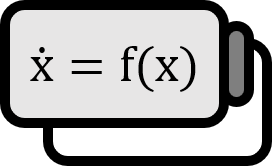A trajectory without a fixed point has at least one zero Lyapunov exponent.
Theorem
Let there be a space $X = \mathbb{R}^{n}$ and a continuous function $f : X \to X$ such that the following vector field is given by the differential equation: $$ \dot{x} = f(x) $$ Assume that the trajectory $x$ of this system is bounded with respect to $t \in [0, \infty)$. If $\left\{ x(t) \right\}$ does not contain a fixed point, then at least one of the Lyapunov exponents of $x$ is $0$.
Explanation
Empirically, when calculating numerical Lyapunov exponents, it is observed that often one of them is $0$. This fact was proven as a theorem by Haken in 1982. Intuitively, this can be geometrically explained by the observation that whether chaotic or periodic, a trajectory passing through some point $x (t)$ naturally comes back to a point very close to $x (t)$ after $T$ time. If it converged to a fixed point, all Lyapunov exponents would be negative, and if it diverged, it would have a positive Lyapunov exponent. However, the fact that it neither stays at a fixed point nor diverges indicates that there is some force bringing $x (t + T)$ back to where it was before, implying it’s not surprising if at least one Lyapunov exponent on average is $0$.
Proof 1
For the given Jacobian matrix $x(t)$ and $f$, define the variational equation as follows: $$ \dot{Y} = J \left( x \right) Y $$ The Lyapunov exponent $\lambda$ of $x$ is defined with respect to some column vector $y(t)$ of $Y$ as follows: $$ \lambda := \limsup_{t \to \infty} {\frac{ 1 }{ t }} \log \left| y(t) \right| $$ From now on, $y$ will not be just any vector but specifically set to $y = \dot{x}$. By differentiating both sides of $\dot{x} = f(x)$ with respect to time, it can be verified by the chain rule that $y = \dot{x}$ is a solution of $\dot{Y} = J Y$. $$ \begin{align*} & \ddot{x} (t) = \dot{f} \left( x (t) \right) \dot{x} (t) \\ \implies & \dot{y} (t) = J \left( x (t) \right) y (t) \end{align*} $$ Here, $\dot{f} \left( x (t) \right) \to J \left( x (t) \right)$ is justified as $J$ is eventually a linearization of $f$ at the point $x(t)$ at time $t$. Given the assumption in the premise that $f$ is a continuous function and $x$ is bounded within $t \in [0, \infty)$, $$ \left| f (x) \right| < D $$ there exists some $D > 0$ satisfying this, $$ \left| y \right| = \left| \dot{x} \right| = \left| f (x) \right| < D $$ and hence $$ \lambda = \limsup_{t \to \infty} {\frac{ 1 }{ t }} \log \left| y(t) \right| \le \limsup_{t \to \infty} {\frac{ 1 }{ t }} D = 0 $$ In other words, it is $\lambda \le 0$.
Now assume $\lambda < 0$. According to the definition of the limit superior, for any $\epsilon > 0$, there exists a time $t_{0}$ that satisfies the following: $$ {\frac{ 1 }{ t }} \log \left| \dot{x} \right| < \lambda + \epsilon \qquad , \forall t > t_{0} $$ Then, choose a small $\epsilon$ such that the $\lambda '$ existing between $\lambda$ and $0$ satisfies $\lambda ' := \lambda + \epsilon < 0$, and define the function $v(t) := v_{0} e^{ - \left| \lambda ' \right| t}$ concerning the function $t$, which is greater than or equal to $\left| \dot{x} \right|$, as follows: $$ \left| \dot{x} \right| \le \left| v_{0} \right| e^{ - \left| \lambda ' \right| t} = \left| v(t) \right| $$ Accordingly, when $t \to \infty$, it must be $\left| \dot{x} \right| \to 0$, which implies that $x$ converges to a fixed point. However, since it was assumed that $\left\{ x(t) \right\}$ does not contain a fixed point, the only remaining possibility is $\lambda = 0$.
■
Haken, H. (1983). At least one Lyapunov exponent vanishes if the trajectory of an attractor does not contain a fixed point. Physics Letters A, 94(2), 71-72. https://doi.org/10.1016/0375-9601(83)90209-8 ↩︎
